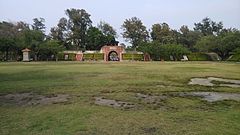Eternal golden castle

|
|
| Data | |
|---|---|
| place | No. 3, Guangzhou Rd, Anping District, Tainan City, Taiwan |
| Art |
fortress
|
| opening | 1874 |
| Website | |
The Eternal Golden Castle ( Chinese 億 載 金城 , Pinyin Yìzǎi Jīn Chéng ) is located in the Anping District , Tainan , Taiwan . Above the gate is a stone tablet by Shen Baozhen with the name of the fortress as an inscription. In addition to being the first modern western fortress in Taiwan, it was also the first to be armed with the English Armstrong cannon , which weighs 18,000 kg.
history
In 1871 shipwrecked traders from the Ryūkyū Kingdom accidentally invaded the area of the indigenous people, the Paiwan . The shipwrecked traders were killed. As a result of this so-called Mudan incident , the Japanese army carried out a punitive expedition in Taiwan . The Qing Dynasty hired official Shen Baozhen to defend Taiwan. He began building the Eternal Golden Castle in September 1874.
Shen Baozhen commissioned the French naval officer Prosper Giquel to design the Eternal Golden Castle. The construction work took two years. In 1876 the first western fortress was completed to protect the coastal area from the Japanese army. During the Sino-French War (August 1884 to April 1885) and during the Formosa Republic's resistance to the Japanese occupation of Taiwan in 1895, when Liu Yongfu and his soldiers fought the Japanese army, the cannons were used to fight the Japanese To defend enemies. The Eternal Golden Castle fell into disrepair under Japanese rule. In addition, the Japanese government sold the cannons in the Russo-Japanese War (February 8, 1904 to September 5, 1905). There was only one rotating bass left in the fortress. The system lost its resistance. It was later classified and preserved as a sight.
In 1975 the Tain city government carried out a major renovation as part of the fortress' 100th anniversary and made a statue of Shen Baozhen and replicas of the cannons and rotating guns of the time.
In 1983 the Ministry of the Interior placed the Eternal Golden Castle under a preservation order.
In 1999 the Eternal Golden Castle was renovated again. During this restoration, the underground ruins of barracks and ammunition depots of the cannons were exposed.
Lords of the castle
In the course of history, the rule of the Eternal Golden Castle changed several times:
| time | Controlled by |
|---|---|
| 1874-1895 | Qing Dynasty |
| 1895-1945 | Japanese rule |
| 1945 until now | Republic of China (Taiwan) |
construction
The property covers approximately 3 hectares. The square fortress is protected by bastions at each of the four corners. The bastions were designed by a French civil engineer named Berthault. The fort now has three replicas of the Armstrong cannon and a 20-pound rotating gun.
The castle gate is 21.67 meters long, 7 meters wide and 6.20 meters high with an arched entrance portal in the style of the Flemish Association . A wooden drawbridge lay over the moat that surrounds the fortress. During a renovation, the drawbridge was replaced by a stone structure.
The central square of the castle was designed as a roll call area that offered space for up to 1,500 soldiers. In 1884 a reservoir was dug in the middle of the roll call area to put out fires caused by artillery attacks. The reservoir is now filled with earth.
The building materials (bricks) came mainly from the neighboring Fort Zeelandia . Since the fortress is on a sand bank, it was not easy to transport the building materials. In addition, there was a lack of building materials at that time. That is why bricks and the remains of Fort Zeelandia were brought here and used as building materials.
Transport links
From Tainan train station with bus lines 14 and 88 to the stop of the Eternal Golden Castle.
Web links
- Ministry of Culture - Cultural Heritage Management Office
- Tainan City Government
- Tourism office of the Tainan city government
Individual evidence
- ↑ 億 載 金城 史蹟 研究. In: his.ncku.edu.tw. Retrieved May 15, 2016 .



